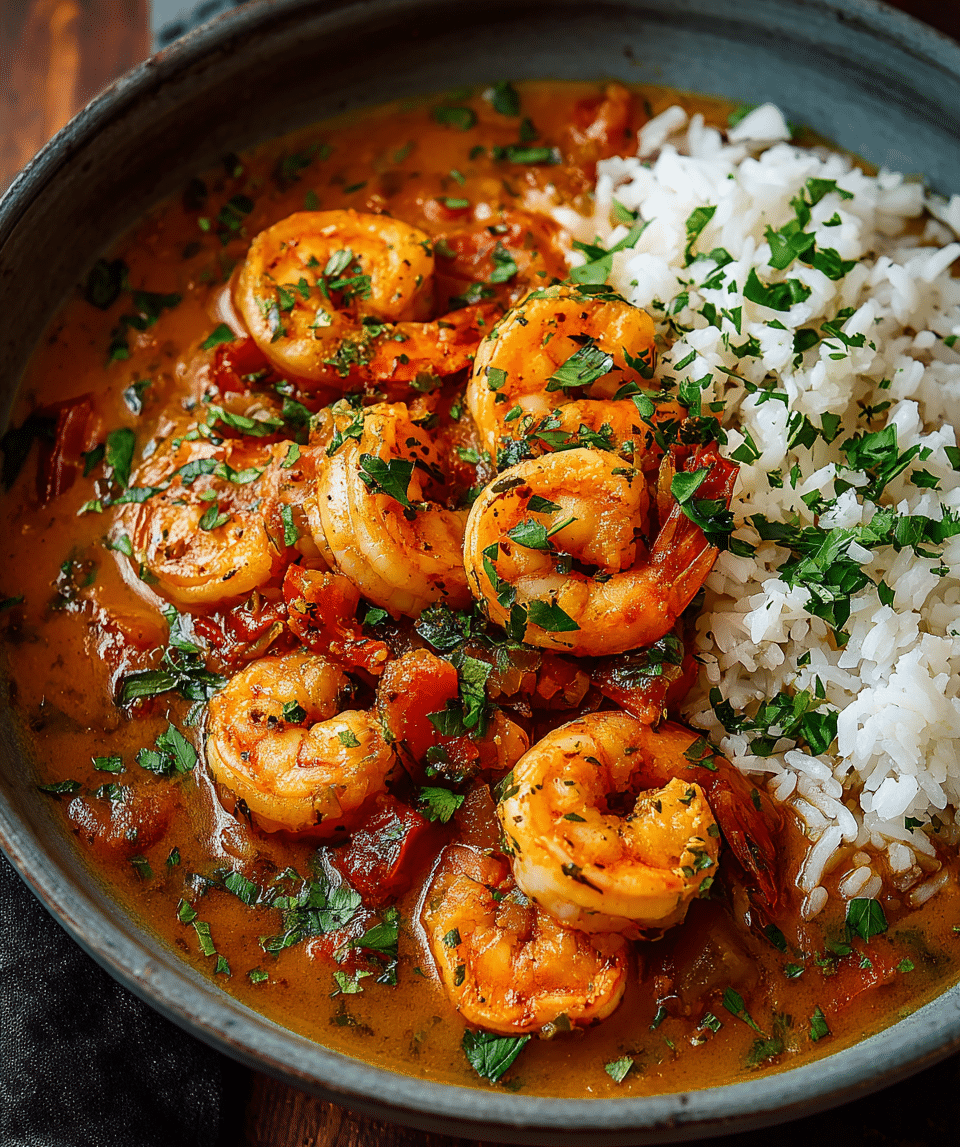Shrimp Étouffée is a classic Cajun and Creole dish that embodies the rich culinary traditions of Louisiana. The term “étouffée” translates to “smothered” in French, referring to the method of cooking shrimp in a flavorful, thickened sauce. This dish combines succulent shrimp with a savory roux-based sauce, seasoned with aromatic vegetables and spices, creating a comforting and hearty meal. Typically served over steamed rice, Shrimp Étouffée offers a delightful balance of flavors and textures that transport you straight to the heart of New Orleans.
Ingredients
-
1 ½ pounds medium shrimp, peeled and deveined
-
1 tablespoon Cajun seasoning
-
1 tablespoon vegetable oil
-
⅓ cup butter
-
⅓ cup all-purpose flour
-
1 small onion, chopped
-
½ green bell pepper, chopped
-
2 ribs celery, chopped
-
¼ teaspoon dried thyme leaves
-
4 cloves garlic, minced
-
3 cups shrimp stock or chicken broth
-
2 cups diced fresh tomatoes
-
3 tablespoons Worcestershire sauce
-
2 bay leaves
-
Salt and black pepper to taste
-
¼ cup sliced green onions
-
¼ cup chopped fresh parsley
-
½ lemon, juiced
-
2 cups cooked rice, for serving
Directions
-
Prepare the Shrimp: Toss the peeled and deveined shrimp with Cajun seasoning. Set aside.
-
Make the Roux: In a large skillet, melt the butter over medium heat. Stir in the flour and cook, whisking constantly, until the mixture reaches a peanut butter color, about 6–8 minutes.
-
Sauté Vegetables: Add the chopped onion, green bell pepper, celery, and dried thyme to the skillet. Cook until the vegetables are tender, about 5 minutes.
-
Add Garlic: Stir in the minced garlic and cook for an additional minute.
-
Incorporate Liquids and Tomatoes: Gradually add the shrimp stock or chicken broth, stirring to combine. Add the diced tomatoes, Worcestershire sauce, and bay leaves. Bring the mixture to a simmer and cook until slightly thickened, about 20 minutes. Season with salt and black pepper to taste.
-
Cook the Shrimp: Add the seasoned shrimp to the skillet. Cook until the shrimp are opaque and cooked through, about 2–3 minutes.
-
Finish the Dish: Stir in the lemon juice, sliced green onions, and chopped parsley.
-
Serve: Spoon the shrimp étouffée over the cooked rice. Garnish with additional green onions and parsley if desired. Serve hot.
Nutritional Information (per serving)
-
Calories: Approximately 424 kcal
-
Total Fat: 15g
-
Saturated Fat: 7g
-
Cholesterol: 369mg
-
Sodium: 1114mg
-
Total Carbohydrates: 30g
-
Dietary Fiber: 2g
-
Sugars: 2g
-
Protein: 41g
-
Vitamin C: 20mg
-
Calcium: 105mg
-
Iron: 7mg
-
Potassium: 526mg
Cajun vs. Creole: The Differences and Their Impact on Shrimp Étouffée
Cajun and Creole are two distinct cultures in Louisiana, and they both have an impact on how Shrimp Étouffée is prepared and served. While both cuisines feature bold, flavorful dishes, they differ in ingredients and techniques.
Cajun cooking is rooted in rural, country-style fare. Historically, Cajun dishes were made using ingredients that were locally available, such as rice, wild game, seafood, and vegetables. The focus was on simple, rustic cooking, often prepared over an open flame or in a cast-iron pot. Cajun cuisine tends to use a lot of spices, especially paprika, cayenne pepper, and garlic, which provide the bold flavors associated with the dishes.
Creole cooking, on the other hand, is more refined and is associated with the urban center of New Orleans. Creole chefs were known for their use of French culinary techniques, and their cooking often included more complex sauces, richer ingredients like cream, butter, and tomatoes, and a wider variety of spices and herbs. The key difference between Creole and Cajun Étouffée lies in the use of tomatoes. Creole-style Shrimp Étouffée often includes fresh or canned tomatoes in the sauce, while Cajun-style versions may omit them, focusing more on the flavors of the seafood and the roux.
Though both styles of cooking have their distinctions, Shrimp Étouffée is beloved in both cultures and can be prepared using either approach, depending on personal preference and regional tradition.
The Key Ingredients in Shrimp Étouffée
Shrimp Étouffée is a relatively simple dish, but its magic lies in the combination of key ingredients that bring it to life. These ingredients are carefully chosen to ensure the perfect balance of flavors that characterize this Louisiana classic.
Shrimp: As the star of the dish, shrimp should be fresh and flavorful. Many people use medium to large shrimp, as their size allows them to absorb the rich flavors of the sauce without overpowering the dish. Fresh shrimp are preferable, but frozen shrimp can also be used, provided they are properly thawed before cooking.
Roux: The base of Shrimp Étouffée is the roux, a mixture of fat (usually butter) and flour. The roux serves as the thickening agent for the sauce and imparts a deep, nutty flavor. The roux must be cooked slowly over medium heat to achieve the right color, which should be similar to peanut butter. This step is essential to the development of the dish’s characteristic flavor.
Vegetables: The “holy trinity” of Cajun and Creole cooking — onions, bell peppers, and celery — form the backbone of the flavor profile in Shrimp Étouffée. These vegetables are sautéed in the roux to release their natural sweetness and enhance the dish’s flavor. Garlic is often added as well, providing an aromatic depth to the dish.
Broth: Shrimp stock or chicken broth serves as the liquid base of the sauce. The broth adds richness and depth to the dish, ensuring that the shrimp are tender and flavorful. Shrimp stock, made from simmering shrimp shells, is ideal for this recipe, as it infuses the dish with a robust, seafood-based flavor.
Spices and Seasonings: A blend of Cajun seasonings, such as paprika, thyme, bay leaves, and cayenne pepper, gives Shrimp Étouffée its signature spice. These spices create a dish with layers of flavor, balancing heat with subtle earthiness. Worcestershire sauce also contributes to the complexity of the sauce, while lemon juice and fresh herbs like parsley and green onions bring a touch of brightness and freshness.
Serving Shrimp Étouffée: The Tradition of Rice
Shrimp Étouffée is typically served over steamed rice, which acts as the perfect base to absorb the rich, flavorful sauce. The rice provides a neutral backdrop to the bold, spicy étouffée, ensuring that each bite delivers a balance of shrimp, sauce, and rice. In Louisiana, long-grain white rice is the traditional choice, as it holds up well to the sauce and doesn’t become mushy.
While the classic presentation involves a serving of Shrimp Étouffée over rice, some variations of the dish might include side dishes such as cornbread, garlic bread, or sautéed vegetables. In restaurants, it’s common to see Shrimp Étouffée served in a large, shallow bowl, with a sprinkle of fresh parsley or green onions on top for garnish. For a truly authentic experience, pairing the dish with a cold, refreshing beverage such as iced tea or a local beer is a must.
Why Shrimp Étouffée is a Favorite Among Locals and Tourists Alike
One of the reasons Shrimp Étouffée is so beloved in Louisiana is its versatility. It can be served at a casual family dinner or as part of a more formal meal. The dish is comforting yet refined, making it ideal for both weeknight dinners and special occasions. The rich, flavorful sauce and tender shrimp offer a satisfying meal that brings people together, and it’s a great way to showcase the bounty of Louisiana’s seafood.
Additionally, Shrimp Étouffée is a dish that can be adapted to suit personal tastes. While the basic recipe remains largely unchanged, home cooks and chefs alike may experiment with different spices, vegetables, or even the type of protein used. Some versions of the dish may include crawfish, crab, or even chicken, adding variety to the dish without straying too far from its core flavors.
The dish’s popularity has extended beyond Louisiana’s borders, and it’s now a staple in many Southern kitchens and restaurants across the United States. Tourists visiting New Orleans often seek out Shrimp Étouffée as part of their culinary tour of the city, eager to taste authentic Creole and Cajun flavors. In fact, it’s not uncommon for visitors to try Shrimp Étouffée in several different restaurants, comparing each version and discovering their favorite.
Conclusion: The Enduring Appeal of Shrimp Étouffée
Shrimp Étouffée is more than just a dish; it’s a cultural experience that embodies the spirit of Louisiana’s culinary heritage. Whether it’s prepared in a Cajun kitchen or a Creole restaurant, this dish brings together a combination of ingredients, techniques, and traditions that reflect the diverse history of Louisiana.
From its origins as a humble, flavorful dish in the bayous to its place as a beloved classic in New Orleans kitchens, Shrimp Étouffée continues to captivate food lovers around the world. With its rich, savory roux, succulent shrimp, and perfectly balanced spices, it’s a dish that never goes out of style. Whether you’re a seasoned cook or a newcomer to Cajun and Creole cuisine, Shrimp Étouffée is a dish that’s worth mastering — a true taste of Louisiana’s heart and soul.






